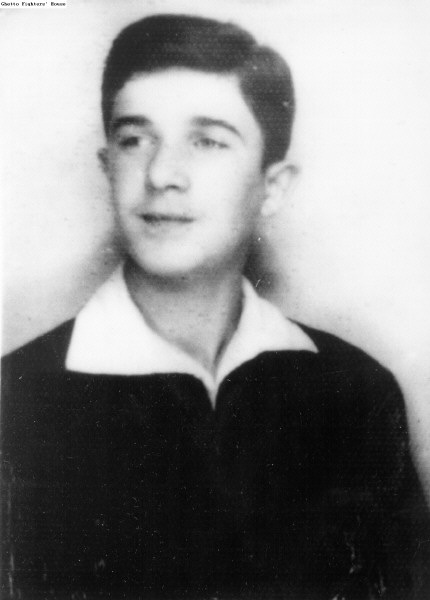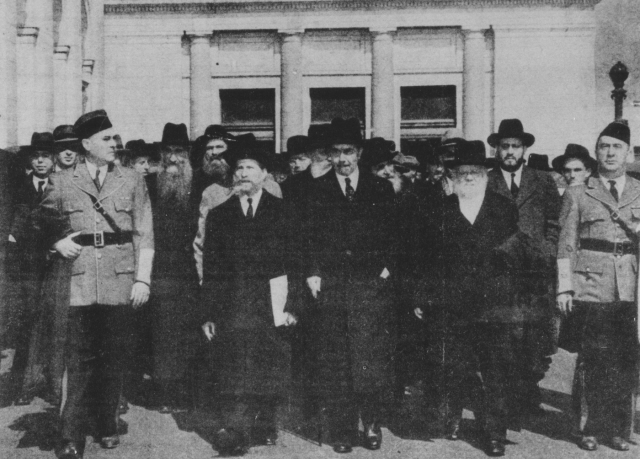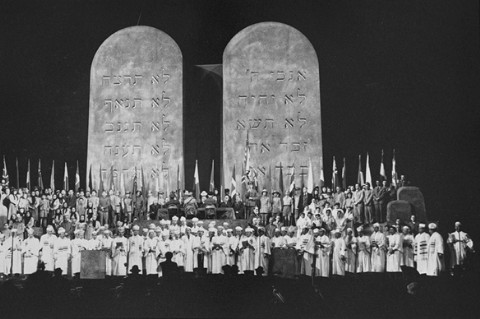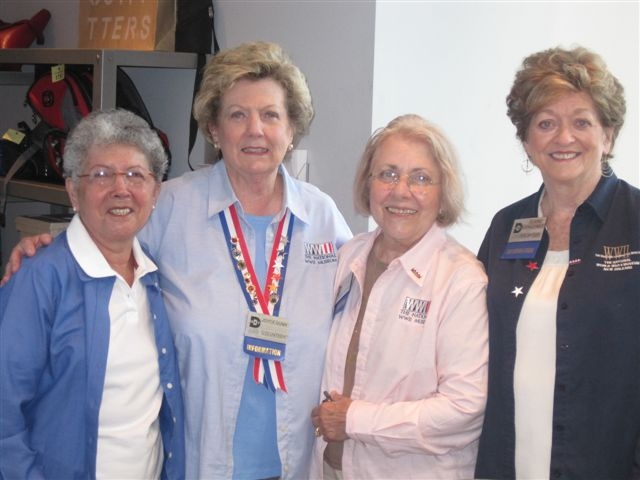Posts Tagged ‘Holocaust’


 On May 8, 1943, Mordechai Anielewicz, along with his girlfriend and other members of the Zionist youth movement at Warsaw, allegedly took his own life as Nazi troops closed in.
On May 8, 1943, Mordechai Anielewicz, along with his girlfriend and other members of the Zionist youth movement at Warsaw, allegedly took his own life as Nazi troops closed in.
Anielewicz had been instrumental in the first act of armed resistance that prevented a major, planned deportation and set off the Warsaw Ghetto Uprising.
There were no eyewitnesses to his death and the whereabouts of his remains are unknown. He was 24 years old.



70 years ago today, delegates from the United States and Great Britain convened in Hamilton, Bermuda to discuss how to handle Jewish refugees who were still at risk for Nazi extermination in occupied areas, and how to handle those who had been liberated by Allied forces but had nowhere safe to go. The conference lasted for 12 days, and today remains a controversial event in WWII’s history.
The United States first learned of the Nazi plan to annihilate European Jewry as early as June 1942. In a report smuggled from Poland to London, it was revealed that the Nazis were using gas vans at Chelmno, one of six eventual death camps the Nazis would operate. It was estimated that 700,000 Jews had already been brought to Chelmno and gassed or shot to death. Official confirmation that Jews were being transported en masse to Auschwitz-Birkenau for forced labor and extermination first reached the Allies in November 1942, prompting a statement condemning “in the strongest possible terms this bestial policy of cold-blooded extermination.” The conference was called in direct response to these reports.
American Jewish leaders attempted to put together a committee to attend the conference, but their request was rejected. They instead sent along proposals on ways to rescue Jewish refugees. The conference attendees, headed by Harold Willis Dodds from the United States and Richard Law from the United Kingdom, ultimately rejected those proposals, and determined that although the Jewish population of Europe was in imminent danger, attention would be better spent on the total war effort in order to not divert Allied attention. Immigration quotas restricting the number of people from foreign countries that could enter the United States were to remain as is (it is worth noting that between 1933 and 1945, the United States allowed in only 132,000 Jewish refugees, which accounted for just 10% of the quota). Additionally, the UK ban that prevented Jewish refugees from obtaining asylum in British-controlled Palestine remained in place. Unknown to the public at the time, American delegates had arrived at the conference with explicit orders from the State Department to accomplish as little as possible, and did just that.
The American Jewish community responded to the conference with outspoken anger and frustration. Many Jewish Americans had family and friends trapped in Nazi-occupied territories. The American Zionist Committee for a Jewish Army ran an advertisement in the New York Times castigating the conference as a “cruel mockery” to the European Jews who were in danger, a move that prompted then-Senator Harry S. Truman to withdraw his membership from the Zionist group. Rabbi Eliezer Silver, leader of the Union of Orthodox Rabbis of the U.S. and Canada, organized a protest with over 400 fellow rabbis and marched through Washington to garner attention for the cause. Working with religious exemptions in immigration quotas, Rabbi Silver managed to rescue roughly 2,000 Jews from certain death.

Rabbi Eliezer Silver (front row, second from left) leads a march of Orthodox rabbis to the Capitol to bring attention to the plight of European Jewry. United States Holocaust Memorial Museum, courtesy of Lillian Silver.
It wasn’t until January 1944, at the urging of Secretary of Treasury Robert Morgenthau, that President Roosevelt acquiesced to the numerous protests and formed the War Refugee Board (WRB), which established refugee camps in North Africa, Italy, Palestine, Sweden and the United States. One of the WRB’s most notable contributions was financing the rescue work of Raoul Wallenberg, whose efforts saved thousands. By the end of the war, it is estimated that nearly 200,000 Jews were rescued through the WRB’s work. Though the WRB lobbied for President Roosevelt to publicly denounce the genocide taking place in Europe, he never did. The WRB was disbanded on September 15, 1945, after the war in Europe had come to an end.
Interested in learning more? View “When They Came for Me,” a K-12 lesson plan about personal and collective responsibility and the Holocaust.
Posted by Gemma Birnbaum, Digital Education Coordinator at The National WWII Museum.



 Seventy years ago, on 9 March 1943, Madison Square Garden swelled with 40,000 people for two performances of the pageant entitled We Will Never Die. A project led by both Hollywood and Broadway elite, We Will Never Die was written by Ben Hecht, produced by Billy Rose, directed by Moss Hart, scored by Kurt Weil and starred Edward G. Robinson, Paul Muni and Sylvia Sydney. The production was subtitled “A Mass Memorial to the Two Million Jewish Dead of Europe” and was intended to rouse Americans to act against the tragic suffering of European Jewry. The pageant featured a cast of hundreds against a backdrop of two forty-foot tall tablets inscribed with the Ten Commandments. Fifty rabbis who had escaped Europe ended the production in reciting the Kaddish, the Jewish memorial prayer for the dead.
Seventy years ago, on 9 March 1943, Madison Square Garden swelled with 40,000 people for two performances of the pageant entitled We Will Never Die. A project led by both Hollywood and Broadway elite, We Will Never Die was written by Ben Hecht, produced by Billy Rose, directed by Moss Hart, scored by Kurt Weil and starred Edward G. Robinson, Paul Muni and Sylvia Sydney. The production was subtitled “A Mass Memorial to the Two Million Jewish Dead of Europe” and was intended to rouse Americans to act against the tragic suffering of European Jewry. The pageant featured a cast of hundreds against a backdrop of two forty-foot tall tablets inscribed with the Ten Commandments. Fifty rabbis who had escaped Europe ended the production in reciting the Kaddish, the Jewish memorial prayer for the dead.
After several performances over two days in New York, the pageant traveled to different venues around the country. Eleanor Roosevelt saw the show in Washington in April and wrote about the performance in her column, My Day: “No one who heard each group come forward and give the story of what had happened to it at the hands of a ruthless German military, will ever forget those haunting words: ‘Remember us.'”
Although the War Refugee Board, which would save nearly 200,000 European Jews lives wasn’t established until January 1944, it is thought that We Will Never Die helped to spread the word about Nazi atrocities and speed the response by Allied nations.
Post by Curator Kimberly Guise.



Special Exhibit – Deadly Medicine: Creating the Master Race
On Display July 25, 2012 – October 15, 2012
From 1933 to 1945, Nazi Germany carried out a campaign to “cleanse” German society of people viewed as biological threats to the nation’s “health.” Enlisting the help of physicians and medically trained geneticists, psychiatrists and anthropologists, the Nazis developed racial health policies that started with the mass sterilization of “hereditarily diseased” persons and ended with the near annihilation of European Jewry. Deadly Medicine: Creating the Master Race traces this history from the early 20th-century international eugenics movement to the Nazi regime’s “science of race.” It also challenges viewers to reflect on the present-day interest in genetic manipulation that promotes the possibility of human perfection.
This exhibition was produced by The United States Holocaust Memorial Museum and sponsored locally by the Tulane School of Medicine.
Schedule of Events
All events are free and open to the public.
Wednesday, August 1, 2012
5:00 pm reception/6:00 pm presentation
The National WWII Museum – Louisiana Memorial Pavilion
Public Opening Reception & Meet the Curator: Dr Susan Bachrach
Join the curator of Deadly Medicine: Creating the Master Race, Susan Bachrach from the United States Holocaust Memorial Museum, as she discusses the creation of this thought-provoking exhibition and the inspiration behind it. For more information, call 504-528-1944 x 229.
Register for this event.
Wednesday, August 8, 2012
6:30 pm – 8:00 pm
The National WWII Museum – Stage Door Canteen
Book Discussion – Sophie’s Choice
The plot ultimately centers around a tragic decision which Sophie was forced to make upon entering the concentration camp. Join us for a discussion on this moving book. For more information, call 504-528-1944 x 229.
Wednesday, August 15, 2012
7:00 pm – 9:00 pm
The National WWII Museum – Stage Door Canteen
Film Screening – Sophie’s Choice
This film tells the story of a Polish immigrant, Sophie, and her tempestuous lover who share a boarding house with a young writer in Brooklyn. The film stars Meryl Streep, Kevin Kline and Peter MacNicol. For more information, call 504-528-1944 x 229.
Thursday, August 23, 2012
3:00 pm – 6:00 pm
The National WWII Museum – The Joe W. and D.D. Brown Foundation Special Exhibit Gallery
Educator Open House
Area teachers are invited to view the special exhibition. Educational materials relating to the exhibit will be available and museum education staff will be on hand to answer questions. For more information, call 504-528-1944 x 229. Pre-registration is requested.
Monday, August 27, 2012
5:00 pm
Tulane School of Medicine – Auditorium, 1430 Tulane Avenue
Justifying the Unthinkable: The ‘Ethics’ of Nazi Medical Experimentation by Arthur Caplan
The field of bioethics has either remained silent in the face of Nazi crimes or accepted the myths that Nazi biomedicine was inept, mad, or coerced. The fact is that many of those who committed the crimes of the Holocaust were competent physicians and scientists who acted from strong moral convictions. The puzzle of how it came to be that physicians and scientists who caused so much suffering and death did so in the belief that they were morally right is the focus of this presentation. For more information, call 504-528-1944 x 229.
Register for this event.
Thursday, September 6, 2012
5:00 pm reception/6:00 pm presentation/7:00 pm book signing
The National WWII Museum – Louisiana Memorial Pavilion
Ethics in Medicine and Research: Lessons from Dr. Mengele’s Lab by Eva Kor
Meet this survivor of Nazi medical experiments and hear her remarkable story. For more information, call 504-528-1944 x 229.
Register for this event.
Thursday, September 13, 2012
6:30 pm
Tulane Uptown Campus – Dixon Hall
The Ethics of Using Medical Data from Nazi Experiments by Baruch Cohen
Following World War II, leading Nazi doctors were brought to justice at Nuremberg after revealing evidence of sadistic human experiments at concentration camps. Since the Nuremberg trials, our society has had to confront the reality that the Nazi doctors were guilty of premeditated murder masqueraded as research. But what about the continued use of the Nazi doctors’ medical research? Is it ever appropriate to use data as morally repugnant as that which was extracted from victims of Nazism? Is so, under what circumstances? Civil Trial Attorney Baruch Cohen presents from a Jewish ethical perspective. For more information, call 504-528-1944 x 229.
Thursday, September 20, 2012
7:00 pm
Newcomb College – Woldenberg Art Center, Freeman Auditorium
Lecture – “The Thief of the Future: The Holocaust – Women, Reproductive Science, Eugenics and the State”
by Laurie Zoloth, Ph.D.
It was not only the lives of Jewish women that were the target of Nazi genocide, it was the very thought of a Jewish future, carried in the bodies of Jewish women. Throughout the campaign of extermination, a second campaign was conducted to prevent reproduction; women bore the brunt of this campaign. The Nazi “experiments” carried out in the name of reproductive science were done by the most prestigious physicians in Germany, as a part of a larger vision of a future in which eugenics shaped the human future. Thus began an era in which the control of the human future was the most critical battleground of all. The 2012 Daspit Women in Science Lecture is presented by Professor Laurie Zoloth, Director of The Brady Program in Ethics and Public Life at Northwestern University. For more information, call 504-865-5422 or email cheaney@tulane.edu.
Wednesday, October 10, 2012
12:00 pm – 1:00 pm
The National WWII Museum – Orientation Center
Lagniappe Lecture – Unit 731 by Walt Burgoyne
In August of 1945, the Soviet Union invaded Japanese Manchukuo. At Japanese compound Unit 731, thousands of rats were released from their cages. They carried millions of bubonic plague-infested fleas to the nearby cities of Harbin and Pingfan. The humans intentionally exposed to plague in camp had already been slaughtered by the Japanese; and the compound burned, to erase damning evidence. Learn about little-known Unit 731, and the unbelievable atrocities committed there, from Education Programs Coordinator Walt Burgoyne. For more information, call 504-528-1944 x 229.
Thursday, October 11, 2012
6:00 pm – 7:30 pm
Panel Discussion – Deadly Medicine’s Influence on Contemporary Public Health Policy
The National WWII Museum – Stage Door Canteen
Looking at the era of “Deadly Medicine” from a public health perspective, what have we learned from it? How do modern medical leaders influence policy by learning from the past? Join local and state medical leaders as they discuss how current medical research has been influenced by the past. Panelists include Dr. Benjamin Sachs, Dean Tulane School of Medicine; Dr. Karen DeSalvo, Commissioner of Public Health, City of New Orleans; Dr. Bruce Greenstein, Secretary Department of Health and Hospitals, State of Louisiana; Dr. Laura Levy, Vice President for Research, Immunology and Microbiology, Tulane University; and Dr Samir El-Dahr, Vice President for Research, Pediatric Nephrology, Tulane University. Dr Guenter Bischof, Director Center Austria, University of New Orleans will introduce.
Register for this event.
Note that some events will be held at off-site locations. Programs subject to change.



January 27th—the anniversary of the liberation of Auschwitz-Birkenau—was designated in 2005 by the UN General Assembly as International Holocaust Remembrance Day. In 2012, the commemorative events and programming are focused on the theme “Children and the Holocaust.” Millions of children suffered acts of mass violence carried out by the Nazis and their collaborators. One and a half million Jewish children perished alongside Roma and Sinti children, disabled children and others.
On this International Holocaust Remembrance Day we would like to recognize and honor one of the Museum’s volunteers. We are very lucky to be able to work with Anne Skorecki Levy, a child survivor of the Holocaust and a Museum volunteer since the beginning.

Anne Skorecki Levy on the left with other dedicated Museum volunteers
(more…)



The “Final Solution” to the Jewish question was decided in the Berlin suburb of Wannsee, in a stately and picturesque building alongside a garden and lake, on January 20, 1942. It is against this incongruous backdrop that history’s most infamous crime, the mass murder of an entire people, was decided upon in bland and bureaucratic proceedings and language. Indeed, the architect of this extermination, Adolf Hitler, was not even present at the meeting, and did not affix his signature of approval to the Wannsee Protocol, the document which is the closest written master plan we possess for the Holocaust.
The central mystery to all queries concerning Adolf Hitler and the Holocaust is, where did the hatred come from? And how could this man gain power in the most advanced nation in Europe, and proceed to implement this monstrous slaughter? Many profiles and much ink has been spilled in the effort to explain and understand how the Final Solution came to pass. Many explanations focus upon Hitler’s inner world and some hidden aberration, such as misplaced anger and blame at his Jewish doctor for failing to cure his mother’s cancer, vague speculations that Hitler’s grandmother had conceived out of wedlock by a married wealthy Jewish employer, claims that Hitler’s rage stemmed from repressed homosexuality, or even that his youthful anger with the Catholic church mutated into an intense hatred of the Jews as persecutors.
Those who seek rational explanation of the Holocaust and Adolf Hitler as historical phenomena cannot find satisfactory answers by the usual means of rational inquiry. But the proper place to seek a rational understanding of this most irrational and horrific event is inside of Adolf Hitler: not in his emotions, but in his mind and the ideas he believed in. Hitler believed in and acted upon a worldview which, however unsound in factual reality, had a horrible logic. It is a testament to the essential inhumanity of himself and his followers that they believed they were acting from motives of beautifying the world.
(more…)


 On May 8, 1943, Mordechai Anielewicz, along with his girlfriend and other members of the Zionist youth movement at Warsaw, allegedly took his own life as Nazi troops closed in.
On May 8, 1943, Mordechai Anielewicz, along with his girlfriend and other members of the Zionist youth movement at Warsaw, allegedly took his own life as Nazi troops closed in.


 Seventy years ago, on 9 March 1943, Madison Square Garden swelled with 40,000 people for two performances of the pageant entitled We Will Never Die. A project led by both Hollywood and Broadway elite, We Will Never Die was written by Ben Hecht, produced by Billy Rose, directed by Moss Hart, scored by Kurt Weil and starred Edward G. Robinson, Paul Muni and Sylvia Sydney. The production was subtitled “A Mass Memorial to the Two Million Jewish Dead of Europe” and was intended to rouse Americans to act against the tragic suffering of European Jewry. The pageant featured a cast of hundreds against a backdrop of two forty-foot tall tablets inscribed with the Ten Commandments. Fifty rabbis who had escaped Europe ended the production in reciting the Kaddish, the Jewish memorial prayer for the dead.
Seventy years ago, on 9 March 1943, Madison Square Garden swelled with 40,000 people for two performances of the pageant entitled We Will Never Die. A project led by both Hollywood and Broadway elite, We Will Never Die was written by Ben Hecht, produced by Billy Rose, directed by Moss Hart, scored by Kurt Weil and starred Edward G. Robinson, Paul Muni and Sylvia Sydney. The production was subtitled “A Mass Memorial to the Two Million Jewish Dead of Europe” and was intended to rouse Americans to act against the tragic suffering of European Jewry. The pageant featured a cast of hundreds against a backdrop of two forty-foot tall tablets inscribed with the Ten Commandments. Fifty rabbis who had escaped Europe ended the production in reciting the Kaddish, the Jewish memorial prayer for the dead.
